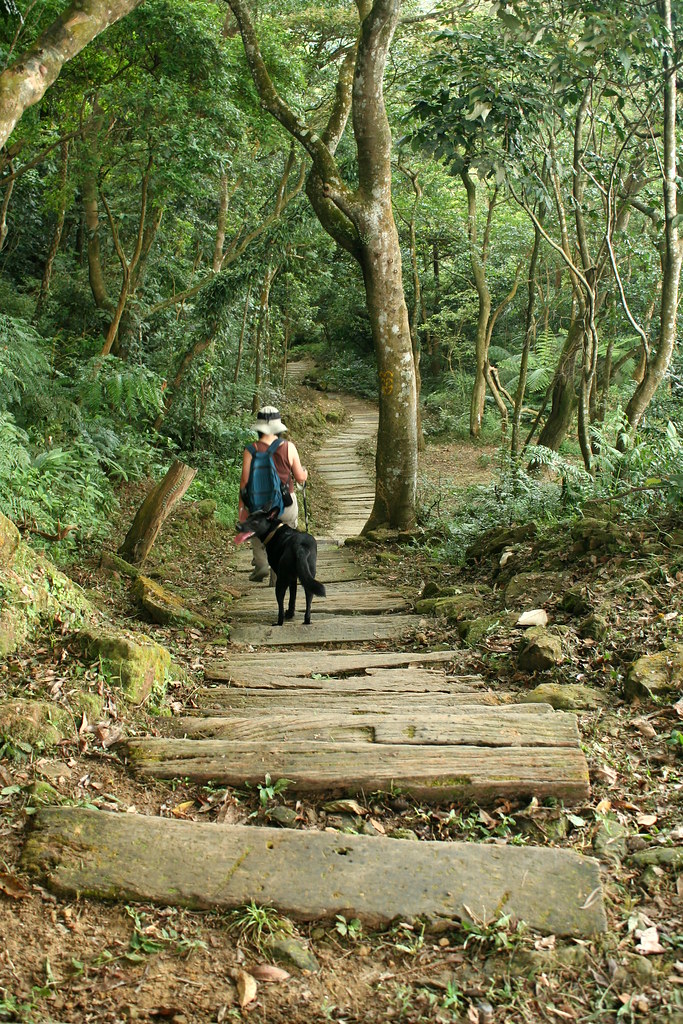
Here's something easy to test the blog waters again. A hike in the hills of Maokong, the tea growing region I am looking out at from my study window even as I type this:

A bit of background:
"Maokong in fact has quite a sweeping history. Originally it was a hunting ground for members of the Atayal indigenous tribe, Chiu said. When the Han Chinese began populating and developing the area, they brought with them a variety of industries. Development of the Maokong area dates back to the Qing Dynasty. The area was known for many different things over the years, including camphor, leeks, rice, Paochung tea, and especially Anhsi tea. After a port was opened in northern Taiwan and trading establishments were created, the area became best known for its tea leaves and its camphor.
During the period of Japanese occupation of the island, the Japanese changed the key industries in Maokong in order to meet the needs of Japan. For example, a tea production and sales organization was set up. In addition, the area became a center for indigo dye and also camphor. The Japanese also began mining the area for coal. After the outbreak of World War II, the Japanese called for the end to planting tea in the area and instead ordered the growing of rice. This had an enormous impact on the industrial make-up of Maokong. Chang Na-miao, an individual in the private sector, decided on his own to import Iron Guanyin tea, which over the years was what Maokong became associated with.
Chiu Yung-chun said that after Retrocession, the tea industry once again gradually took hold on Maokong. In 1987, when former President Lee Teng-hui was still in his position as the mayor of Taipei, he promoted the establishment of tourist tea plantations in Mucha."
Despite the couple hundred years of development it's mostly a jungle up there, and a remarkably dense one just at the doorstep of Taipei. One Sunday in August we rode up to Sanxuan Temple at the end of the gondola line (not running at the moment). A set of stairs beside the temple leads to a wonderful network of trails, much of it running along a ridgeline that extends to the coast.
We started up the stairs but then quickly took a right side path through the tea fields. In the dense forest above us we heard dozens of Muller's Barbet chattering away (pic from wikipedia).

A number of massive old tombs looked out over the city.

Not far along we found a couple wax apple trees overloaded with overripe fruit and snagged some for lunch. On the other side of a gully we picked up a main trail and followed it to an obvious junction on the backside of the ridgeline I mentioned above (it was at its lowest point here). It's a pretty area of terraced tea fields and open views. We headed down a dirt path and swung round the contours of the slopes passing a small farmhouse with a lotus pond.
I can't believe I forgot to take a pic of the farmhouse. Not only does it have a great rustic charm, but more importantly it's where I have always planned to hide out when the Chinese invade. Next time.
The section of trail past the farmhouse has been a favorite for years. I find it pretty, peaceful and full of simple charms.

After reaching a pass, the trail dropped into a narrow valley through which flows a small clean stream. The stream has a classic feel to it, but is a bit odd in this region as there are no eroded stones in the bed. I'll let my friend Richard Saunders explain this:
"Ever wondered where Maokong, that ever-popular hillside on the southern edge of Taipei where everyone goes to drink tea, got its name? Despite having the character for 'cat' in the name, it has nothing whatsoever to do with our feline friends.
Instead it's a transliteration of the Taiwanese name, 'Niaokeng,' ('teapot hole'), an allusion to the many potholes eroded into the rock of the riverbed in the valley below. For many years this fascinating sight was visited by few visitors to the area other than local geologists, but now the potholes are easy to get to, thanks to a new, well signposted path that begins not far from the upper station of the Maokong Gondola (forecast to reopen for Chinese New Year 2010).
Potholes (otherwise known as kettle holes or giant's kettles) occur when small stones or gravel, spun in a circular motion by eddies in the water, gradually erode smooth-sided, circular depressions in a stream or riverbed. These examples at Muzha might not look especially big or impressive, but they're of great interest to geologists, as they're quite uncommon."
Here's a pic of a large section of teapot holes on the Keelung River near Shifen.
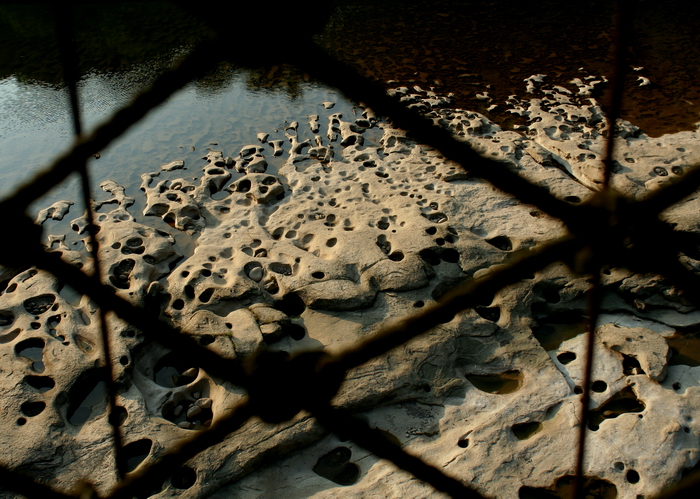
In any case, as Richard says, one of the best streams for viewing the teapot holes in Maokong is close to the gondola. It's worth a look when you are in the area.
At the end of a long series of wood steps we reached a grassy field at the bottom of the valley. A number of colorful swallowtail butterflies fluttered up and circled overtop. Maokong doesn't have big colonies of butterflies but it does have a nice variety of species and they are comfortable with people.
We crossed the stream on a small wooden bridge and then headed down. The trail ran close to the water for half a kilometre and then made a sweep to the left as it hugged a rather precipitous cliff wall. The steps were now cut into the stone and rather slippery on this humid day. We held on to the metal railing and inched our way down slowly. Katanya picked up Xian Cao (her three-legged dog) and carried him down.
Most of the group had now idea what to expect at the bottom so it was fun to watch their reaction when this popped up:

It's a small branch temple of the larger and more well known Zhinan Temple that overlooks Muzha (and is the penultimate stop on the gondola). I discovered it quite by accident about 10 years ago and have been coming ever since once or twice a year.
The temple is carved into the cave behind a 30m waterfall and you can walk into it, and get behind the falls, on the weekends and explore.
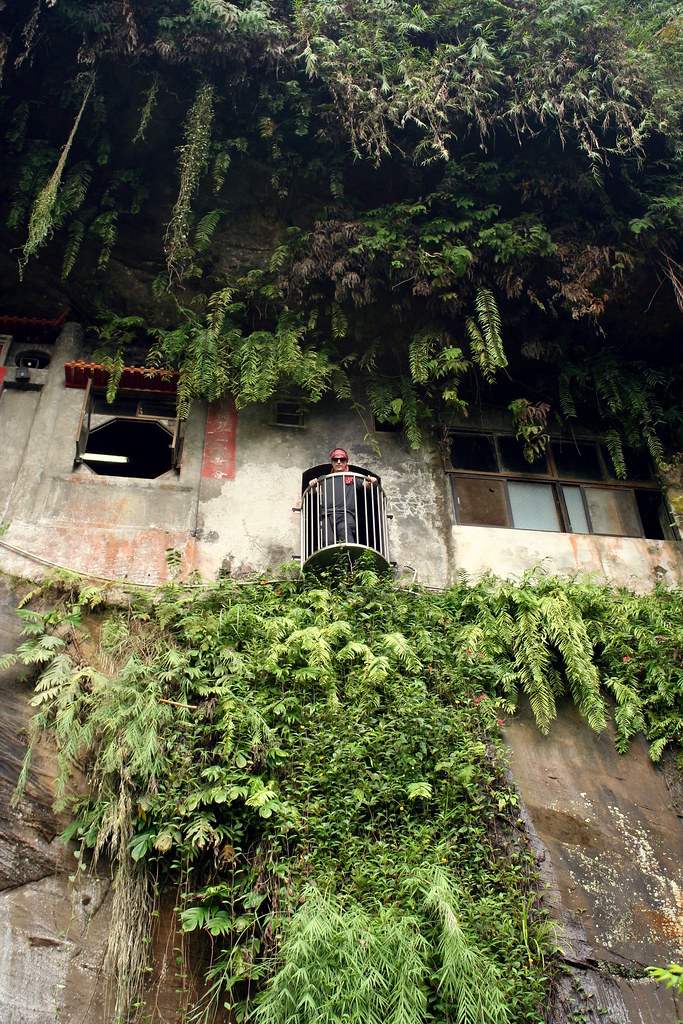
There's not so much to see inside though one wall has some interesting faded Buddhist script, and the caretakers are usually around offering tea to visitors. Sure enough that afternoon we were plied with cup after cup of Baozhong, a locally grown oolong. I had always thought Tieguanyin (Iron Guanyin) was grown in Maokong but the caretaker informed me that both are grown: Tieguanyin is planted on the other side of the ridge, closer to Taipei, while Baozhong is grown in the region closer toward Pinglin.
After lunch and tea we started back. At the bridge we continued upstream rather than crossing the bridge and returning the way we came. This is another favorite section of trail. Though Taipei sits just on the other side of the ridge, there is a palpable feeling that you have gotten away from it all. Or perhaps gotten back in time. The stream flows through a narrow but steep ravine. Some sections have manmade stone retaining walls and near the end an old rotted-out bridge crosses the junction of two small streams.
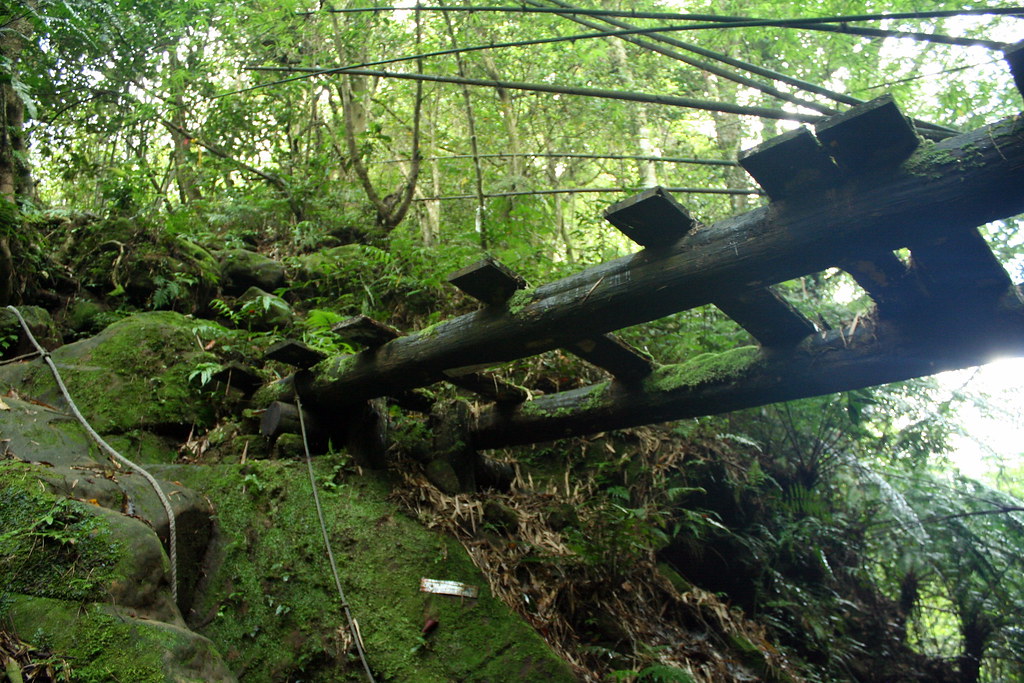
I love this spot though Xian Cao took some time to appreciate it.
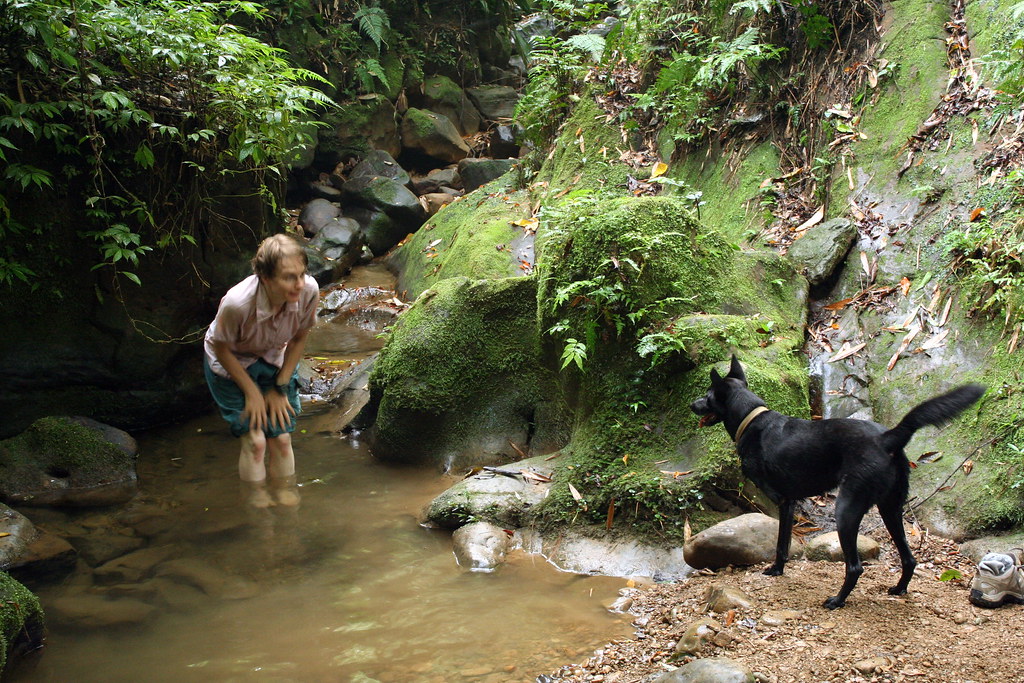
At the confluence (if it can be called that), we headed up the left stream and then began a fast ascent to the ridgeline. It's a 30-minute climb through a lush forest that very few hikers take. Lots of beautiful old bamboo stands left over.
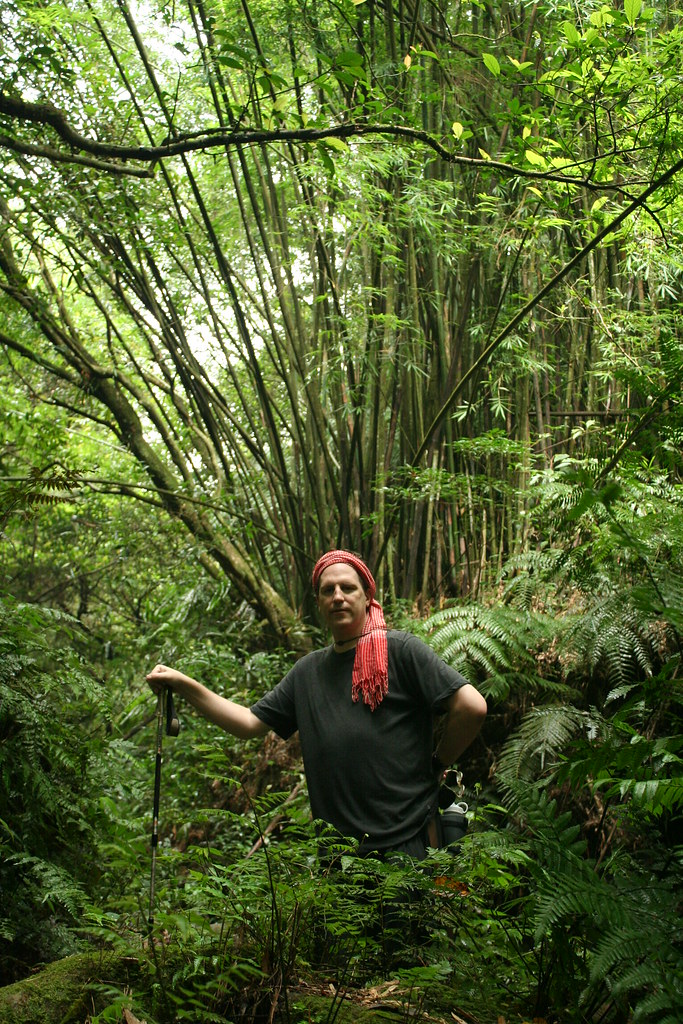
The stream is tiny here and flows through any even tinier canyon. It's perfect river tracing terrain for toddlers (Peter are you listening?).
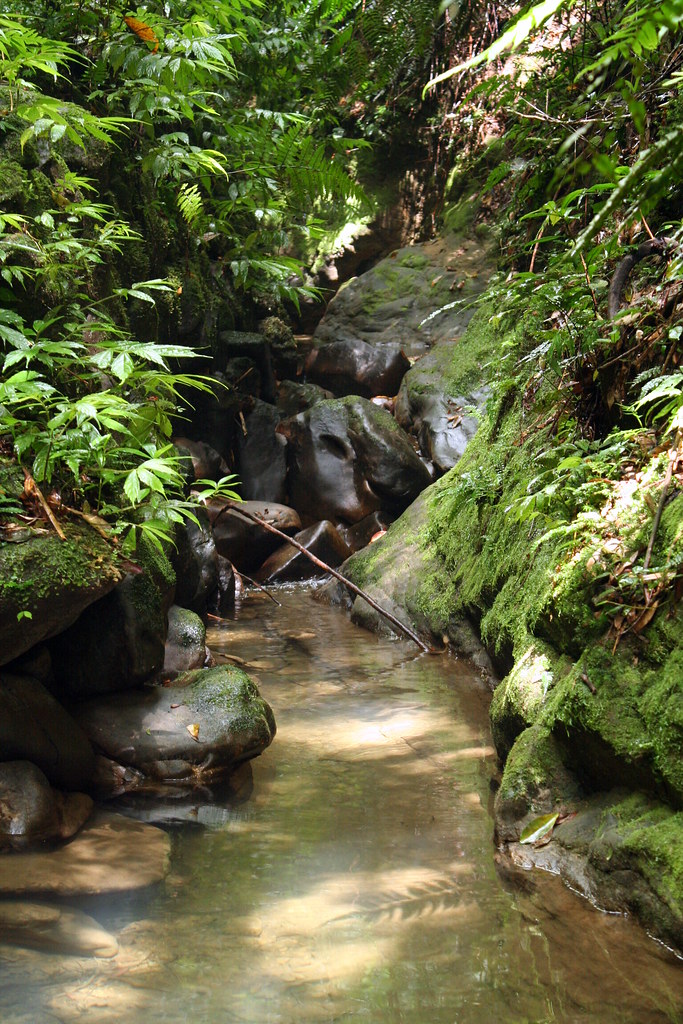
At the ridge, there is a wide clearing and a junction of trails. Straight down takes you to the Maoking gondola station and Sanxuan Temple where we began. To the right is a splendid 2.5 hour walk to Ergeshan, the highest mountain in the southern foothills that ring Taipei.
We went left. At first we strolled along the ridgetop through open fields. Taipei spread below us and on a clear day like this looks pretty attractive (in general I think the city looks best from the south). In one clearing we could look east to Ergeshan, the last of the rolling summits in this pic:

And then it was down the ridge along a narrow trail, hemmed in by ferns and a forest of machilus and acacia.
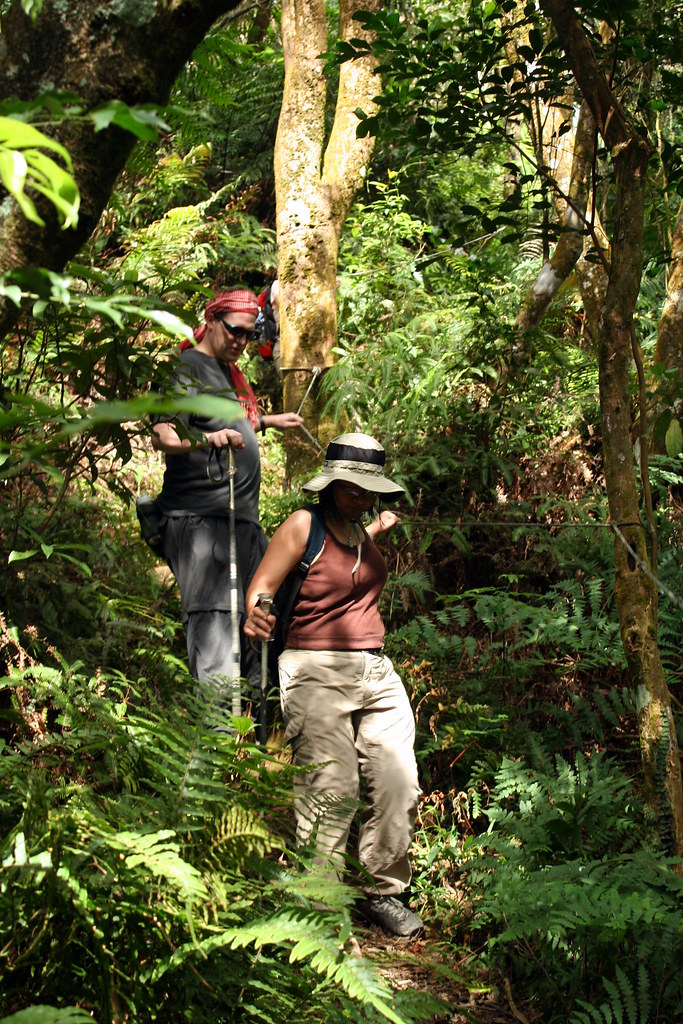
In one dense section of woodland, a pair of black bulbuls (an endemic sub-species) in the trees above warned us away with their terrible squawks. Beautiful if rather territorial creatures. From the birding in Taiwan website:
Later, Chris found this wonderful but deadly mushroom. Notice the slug speeding up the side?
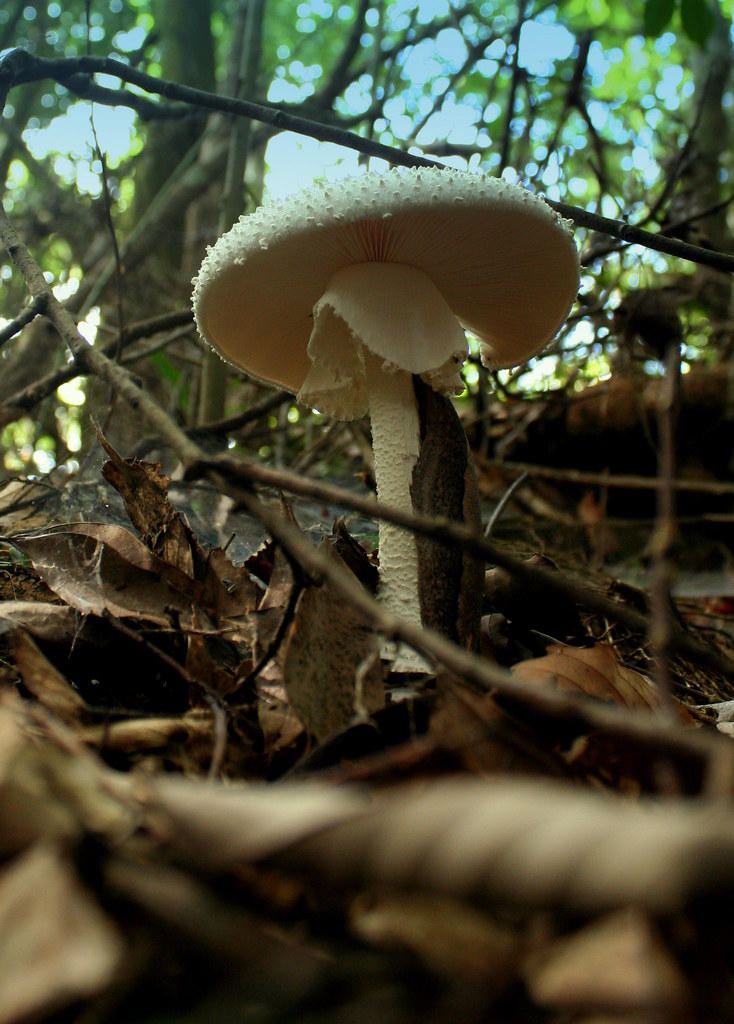
The trail eventually led us back to the lowest point of the ridgeline where we had stood a few hours earlier. We skipped back down to the road and on the way to the car (only 1km at this point) stopped in at Xiao Mu Wu (Little Wood House) one of our favorite restaurant-teahouses in Maokong.
We ate dinner and watched the sunset over Taipei.
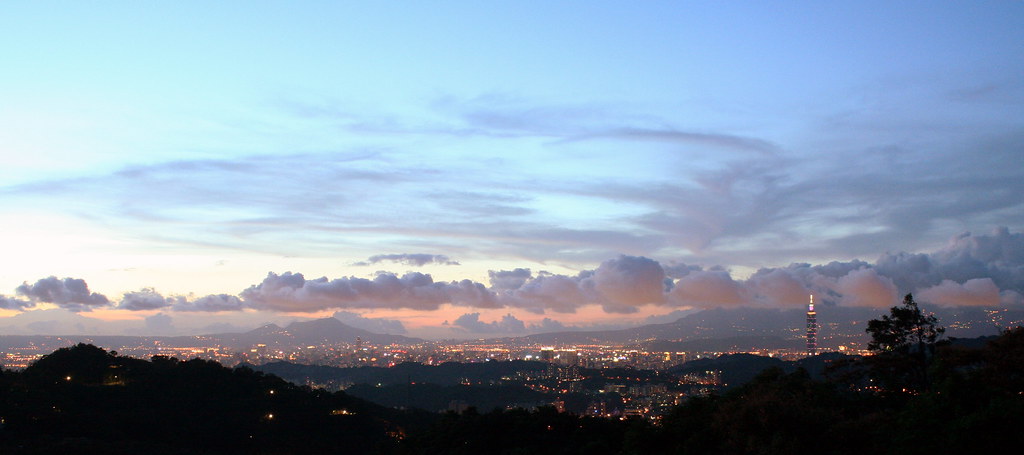
Practicalities:
When the gondola reopens, as it should by the end of 2009, this hike will once again be a natural for anyone looking to get out of the city for a few hours. Just get off the gondola at the last stop (Maokong) and cross the road. Look for a set of stairs kitty corner and follow them up, turning right about 150m along.
This is a hike for all seasons and weather conditions. I particularly love the area on a misty day.
As this is just a hop from my house, the Dutch can get a lift with me by car anytime they visit. Which I hope is soon.
For more on the name Maokong see this article from Tailingua.
Here's the name card for the restaurant.

Practicalities: